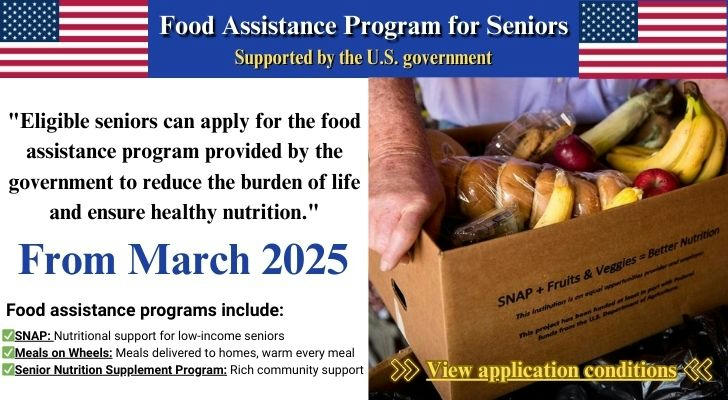Senior Food Assistance Guide: Benefits, Eligibility, and How to Apply
Introduction: The Growing Issue of Food Insecurity Among Seniors
More and more seniors in the U.S. face food insecurity, especially those with low incomes, health issues, or living alone. In 2025, about 5.3 million seniors struggle to afford enough nutritious food, making it hard for them to stay healthy. Fortunately, the government offers food assistance programs to help eligible seniors get the nutrition they need and ease financial stress. Keep reading to learn how you can apply for this support and improve your quality of life.

Overview of Senior Food Assistance Programs: What Options Are Available?
- SNAP: Supplemental Nutrition Assistance Program
SNAP helps low-income families, including seniors, buy enough food. In 2025, over 45 million people benefit from SNAP, including many seniors. This program helps seniors buy healthy foods, so they don't have to worry about going without meals.
How to Apply: You can apply online or visit your local social services office. You’ll need to provide proof of income, household details, and other information.
Eligibility: The income limits vary by state, so check local policies for specific details.
- Meals on Wheels: Delivering Meals to Your Door
For seniors who have trouble leaving home, Meals on Wheels is a crucial service. It delivers hot, nutritious meals directly to their door. This program is expected to serve over 2 million seniors in 2025. Meals on Wheels is perfect for seniors who can’t shop or cook for themselves.
How to Apply: Contact your local Meals on Wheels program to apply. They will assess your needs and determine eligibility.
Eligibility: Meals on Wheels is mainly for seniors who are homebound due to health or mobility issues.
- Senior Nutrition Programs: Local Community Support
Many community-based programs also provide meals for seniors. These programs are often run by local organizations, churches, and other groups. They offer daily or weekly meals to help seniors maintain a healthy diet.
How to Apply: You can contact your local community center to find out how to apply for nutrition programs.
Eligibility: These programs are usually for seniors aged 60 and over, especially those facing food insecurity.
The Benefits of Senior Food Assistance Programs: How They Improve Your Life
These government-supported food programs do more than just provide meals—they improve seniors’ quality of life. Here’s how:
- Nutritious Meals: Ensuring a Healthy Diet
By participating in these programs, seniors can make sure they eat healthy meals every day. This is especially important for seniors with chronic health conditions or those who struggle with cooking.
- Reducing Financial Stress: Saving Money for Other Needs
Food is often one of the biggest expenses for low-income seniors. Programs like SNAP and Meals on Wheels help reduce food costs, so seniors can spend money on other needs, like healthcare or housing.
- Social Support: Reducing Loneliness
Many meal delivery services also help reduce loneliness. Meals on Wheels, for example, not only delivers food but also provides a chance for seniors to interact with others, helping them feel less isolated.
How to Apply for Senior Food Assistance
Applying for these food assistance programs is simple. Whether you’re interested in SNAP, Meals on Wheels, or other local programs, here’s how to apply:
- SNAP Application Process:
Apply online or visit your local social services office.
Provide income proof, identification, and household details.
Expect to hear back within 30 days.
- Meals on Wheels Application Process:
Contact your local Meals on Wheels organization to see if you qualify.
Provide necessary details, such as health status, address, and meal needs.
Once confirmed, meals will be delivered regularly.
- Local Senior Nutrition Programs:
Contact community centers or local organizations to learn about available programs.
Some programs provide meals delivered to your home, while others offer meals at pick-up locations.
Case Study: Mary’s Story—How Food Assistance Changed Her Life
Mary, 75, lives alone and has health problems that make it hard for her to shop and cook. She struggled with high food costs on her fixed income. After applying for Meals on Wheels and SNAP, she now receives nutritious meals at home and a food allowance to buy groceries. Her quality of life has improved significantly, and she no longer worries about food.
Mary’s story is a great example of how food assistance programs help seniors regain control of their lives and enjoy better nutrition and social connections.
Conclusion: Apply for Food Assistance and Improve Your Quality of Life
The U.S. government offers many food assistance programs that help seniors ensure they have enough to eat. Whether it’s through SNAP, Meals on Wheels, or other local programs, seniors can get the support they need to live healthier lives. Check if you qualify and apply today to start receiving this valuable assistance and enjoy peace of mind about your meals!
